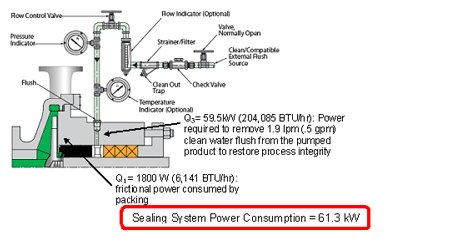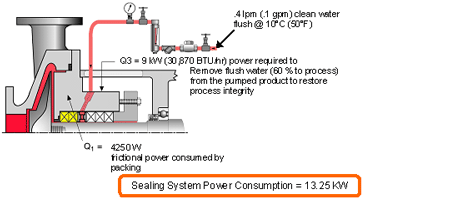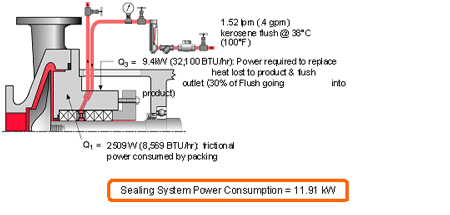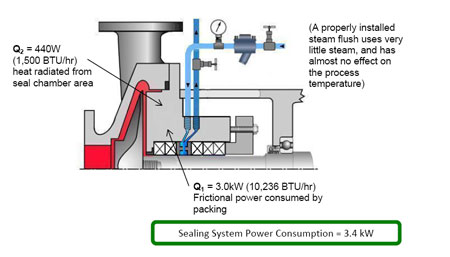Compression packing has continuously been used to seal pump shafts in many applications. For most applications, the packing relies on the product itself for lubrication and cooling. In some applications, however, the pumped product cannot provide sufficient cooling or be used for lubrication. This can happen when the product is at elevated temperature, when solids are present because of contamination, or a slurry is pumped. In these cases, external cooling and lubrication are needed to enable optimal sealing performance of the packing.
Flush Systems
In flush systems, a clean and cool source of liquid is piped to the packing area. This liquid, most commonly referred to as a flush, lubricates the packing and effectively serves to seal the product from entering the stuffing box. Many different arrangements are used, but the most common is to inject the flush into a connection in the stuffing box, which is the cylindrical chamber in which the packing is placed. The connection goes to a lantern ring, which is positioned inside the stuffing box. The lantern ring allows the flush fluid to be evenly distributed around the shaft.
The arrangement is simple, but it can tremendously impact the entire system's energy consumption, depending on how it is used. Careful analysis actually reveals that the power consumption of some systems can be staggering.
Applications
We will look at a couple of examples where a flush will be used with compression packing. The first involves a slurry, and the second involves the pumping of a high temperature product like hot water or hot oil. In all cases, the energy consumed by the system will include the frictional energy created by the compression of the packing around the shaft and delivered by the prime mover, usually an electric motor. While not insignificant, that frictional energy can be far smaller than the thermal energy that the flushing system consumes.
Slurry
In the first arrangement, the pumped product is a slurry, and a clean water flush is injected ahead of the packing (see Figure 1). The flush water injected into the product must be evaporated later to restore the integrity of the process.

Figure 1. Basic slurry flush system
An alternative arrangement (see Figure 2) uses five rings of packing-three rings for sealing, and two (between the lantern ring and the slurry) made of high strength fibers that can resist abrasion from the slurry. The amount of flush water that will need to be evaporated is much less than in the previous case, so the system is more energy efficient.

Figure 2. Modified slurry flush system
Hot Oil
In a second scenario, a hot oil product is cooled by external kerosene flush. The total energy consumed is not only that needed to overcome the packing friction but also the additional thermal energy required to bring the cool injected fluid to system temperature. That thermal energy is approximately 80 percent of the energy that the system consumes. Figure 3 illustrates the case where a low temperature packing is cooled to achieve reliable operation.

Figure 3. Basic Hot Oil flush system
A better option is to use a high temperature packing with a steam injection to prevent coking and also provide some measure of cooling. The energy consumption in this case is mostly the heat radiated to the environment and the frictional heat of the packing.

Figure 4. Modified hot oil flush system
Conclusion
While other energy efficient packing systems exist for specific applications, these examples illustrate the relative impact frictional losses and environmental systems have on the overall energy consumption of a compression packing sealing system. Surprisingly, the environmental system is often the much greater consumer of energy since thermal sources are often less apparent.
These examples also show that more energy efficient systems are based on proper selection of the packing material and design with the environmental control system. Applying this approach can significantly reduce overall energy consumption and cost as well as the impact of the process on the external environment. Consulting a compression packing manufacturer will help ensure selection of the most energy efficient compression packing system.
For more information on packing systems see the FSA Compression Packing Technical Manual- Third Edition
Next Month: Which Piping Plan should I choose API 53A, 53B or 53C?
Pumps and Systems, April 2010

